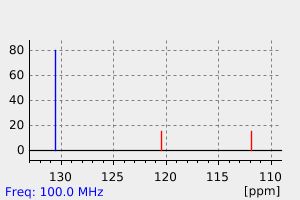1-phenyl-1H-1,2,3-triazole-4-carbonitrile | 61456-87-9
中文名称
——
中文别名
——
英文名称
1-phenyl-1H-1,2,3-triazole-4-carbonitrile
英文别名
4-cyano-1-phenyl-1,2,3-triazole;1-phenyl-1H-[1,2,3]triazole-4-carbonitrile;1-Phenyl-1H-[1,2,3]triazol-4-carbonitril;1-phenyltriazole-4-carbonitrile
CAS
61456-87-9
化学式
C9H6N4
mdl
——
分子量
170.173
InChiKey
BKFLGIQLHBKHKO-UHFFFAOYSA-N
BEILSTEIN
——
EINECS
——
-
物化性质
-
计算性质
-
ADMET
-
安全信息
-
SDS
-
制备方法与用途
-
上下游信息
-
文献信息
-
表征谱图
-
同类化合物
-
相关功能分类
-
相关结构分类
物化性质
-
熔点:121-122 °C
-
沸点:369.6±34.0 °C(Predicted)
-
密度:1.23±0.1 g/cm3(Predicted)
计算性质
-
辛醇/水分配系数(LogP):1.4
-
重原子数:13
-
可旋转键数:1
-
环数:2.0
-
sp3杂化的碳原子比例:0.0
-
拓扑面积:54.5
-
氢给体数:0
-
氢受体数:3
SDS
上下游信息
-
上游原料
中文名称 英文名称 CAS号 化学式 分子量 1-苯基-1H-1,2,3-噻唑-4-甲醛 1-phenyl-1,2,3-triazole-4-carbaldehyde 34296-51-0 C9H7N3O 173.174 1-苯基-4-甲醇基-1H-1,2,3-三唑 (1-phenyl-1H-1,2,3-triazole-4-yl)methanol 103755-58-4 C9H9N3O 175.19 5-氨基-1-苯基三唑-4-腈 5-amino-1-phenyl-1H-1,2,3-triazole-4-carbonitrile 20271-39-0 C9H7N5 185.188 —— (E)-1-phenyl-1H-1,2,3-triazole-4-carbaldehydeoxime 133902-54-2 C9H8N4O 188.189 1-(对硝基苯基)-1,2,3-三唑-4-甲醛 1-(4-nitrophenyl)-1H-1,2,3-triazole-4-carbaldehyde 113934-26-2 C9H6N4O3 218.172 1-(4-硝基苯基)-1H-1,2,3-三唑-4-甲醇 (1-(4-nitrophenyl)-1H-1,2,3-triazol-4-yl)methanol 90886-87-6 C9H8N4O3 220.188 -
下游产品
中文名称 英文名称 CAS号 化学式 分子量 —— 1-phenyl-1H-[1,2,3]triazole-4-carboxylic acid 4600-04-8 C9H7N3O2 189.173 (9ci)-1-苯基-1H-1,2,3-噻唑-4-羰酰氯 1-phenyl-1H-1,2,3-triazole-4-carboxylic acid chloride 134541-91-6 C9H6ClN3O 207.619
反应信息
-
作为反应物:描述:1-phenyl-1H-1,2,3-triazole-4-carbonitrile 在 氯化亚砜 、 sodium carbonate 、 sodium hydroxide 作用下, 以 二氯甲烷 、 水 、 甲苯 为溶剂, 反应 13.0h, 生成 N-(3-fluoro-4-((6-methoxy-7-(3-(4-methylpiperazin-1-yl)propoxy)quinolin-4-yl)oxy)phenyl)-1-phenyl-1H-1,2,3-triazole-4-carboxamide参考文献:名称:Discovery of a novel 6,7-disubstituted-4-(2-fluorophenoxy)quinolines bearing 1,2,3-triazole-4-carboxamide moiety as potent c-Met kinase inhibitors摘要:A series of 6,7-disubstituted-4-(2-fluorophenoxy)quinoline derivatives possessing 1,2,3-triazole-4-carboxamide moiety were designed, synthesized and evaluated for their in vitro cytotoxic activities against four typical cancer cell lines (A549, H460, HT-29, and MKN-45). Most compounds showed moderate-to-excellent antiproliferative activity. Compounds 32, 36, 37, 45, 51, and 52 were further examined for their inhibitory activity against c-Met kinase. The promising compound 37, with a c-Met IC50 value of 2.27 nM, was identified as a multitargeted receptor tyrosine kinase inhibitor. The analysis of their structure-activity relationships indicated that compounds with EWGs, especially chloro group, at 2-position on the phenyl ring (moiety B) have potent antitumor activity. (C) 2016 Elsevier Masson SAS. All rights reserved.DOI:10.1016/j.ejmech.2016.04.035
-
作为产物:描述:1-苯基-4-甲醇基-1H-1,2,3-三唑 在 manganese(IV) oxide 、 盐酸羟胺 作用下, 以 甲醇 、 二氯甲烷 、 二甲基亚砜 为溶剂, 反应 98.0h, 生成 1-phenyl-1H-1,2,3-triazole-4-carbonitrile参考文献:名称:L'abbe, Gerrit; Bruynseels, Maria; Delbeke, Pieter, Journal of Heterocyclic Chemistry, 1990, vol. 27, # 7, p. 2021 - 2027摘要:DOI:
文献信息
-
Flow Hydrodediazoniation of Aromatic Heterocycles作者:Liesa Röder、Alexander J. Nicholls、Ian R. BaxendaleDOI:10.3390/molecules24101996日期:——Continuous flow processing was applied for the rapid replacement of an aromatic amino group with a hydride. The approach was applied to a range of aromatic heterocycles, confirming the wide scope and substituent-tolerance of the processes. Flow equipment was utilized and the process optimised to overcome the problematically-unstable intermediates that have restricted yields in previous studies relying
-
Copper Acetate Catalyzed Regioselective Synthesis of Substituted 1,2,3-Triazoles: A Versatile Azide-Alkene Cycloaddition/Oxidation Approach作者:Sandeep Rohilla、Shyam Sunder Patel、Nidhi JainDOI:10.1002/ejoc.201501301日期:2016.2A copper acetate catalyzed oxidative cycloaddition reaction of benzyl and aryl azides with terminal and internal olefins that contain electron-withdrawing groups (COOR, CONH2, CN, CHO, COR) has been developed. The reaction employs air as the oxidant and does not require any base or additives to afford 1,4-disubstituted and 1,4,5-trisubstituted 1,2,3-triazoles in good to excellent yields with high regioselectivity
-
Three-Component Reactions with Sterically Crowded 2,2,4,4-Tetramethyl-3-thioxocyclobutanone, Phenyl Azide, and Electron-Deficient C,C-Dipolarophiles作者:Grzegorz Mlosto?、Jaroslaw Roma?nski、Anthony Linden、Heinz HeimgartnerDOI:10.1002/hlca.19960790507日期:1996.8.7In order to trap ‘thiocarbonyl-aminides’ A, formed as intermediates in the reaction of thiocarbonyl compounds with phenyl azide, a mixture of 2,2,4,4-tetramethyl-3-thioxocyclobutanone (1), phenyl azide, and fumarodinitrile (8) was heated to 80° until evolution of N2 ceased. Two interception products of the ‘thiocarbonylaminide’ A (ArPh) were formed: the known 1,4,2-dithiazolidine 3 (cf. Scheme 1) and为了捕获在硫代羰基化合物与叠氮化苯反应中作为中间体形成的``硫代羰基氨基化物'' A,需要使用2,2,4,4-四甲基-3-硫代氧杂环丁酮(1),叠氮化苯和富马腈的混合物(将8)加热至80°,直到N 2的放出停止。形成了两个“硫代羰基氨基化物” A(ArPh)的拦截产物:已知的1,4,2-二噻唑烷3(参见方案1)和新的1,2-噻唑烷12(方案2)。后者的结构通过X射线晶体学确定(图1)。与富马酸二甲酯类似的“三组分反应”(除了已知的拦截产物3和6(方案1)之外,由9)代替8得到了两个意外的产物15和16(方案3),其结构通过X射线晶体学得以阐明(图2)。 。它们的形成是通过重氮化合物的初级[2 + 3]环加成合理化18与1,得到19,接着进一步反应(级联方案4)。
-
Redirection of sialic acid metabolism in genetically engineered Escherichia coli作者:M. Ringenberg、C. Lichtensteiger、E. VimrDOI:10.1093/glycob/11.7.533日期:2001.7.1Most microorganisms do not produce sialic acid (sialate), and those that do appear to use a biosynthetic mechanism distinct from mammals. Genetic hybrids of nonpathogenic, sialate-negative laboratory Escherichia coli K-12 strains designed for the de novo synthesis of the polysialic acid capsule from E. coli K1 proved useful in elucidating the genetics and biochemistry of capsule biosynthesis. In this article we propose a dynamic model of sialometabolism to investigate the effects of biosynthetic neu (N-acetylneuraminic acid) and catabolic nan (N-acylneuraminate) mutations on the flux of intermediates through the sialate synthetic pathway. Intracellular sialate concentrations were determined by high pH anion exchange chromatography with pulsed amperometric detection. The results indicated that a strain carrying a null defect in the gene encoding polysialyltransferase (neuS) accumulated > 50 times more CMP–sialic acid than the wild type when strains were grown in a minimal medium supplemented with glucose and casamino acids. Metabolic accumulation of CMP–sialic acid depended on a functional sialic acid synthase (neuB), as shown by the inability of a strain lacking this enzyme to accumulate a detectable endogenous sialate pool. The neuB mutant concentrated trace sialate from the medium, indicating its potential value for quantitative analysis of free sialic acids in complex biological samples. The function of the sialate aldolase (encoded by nanA) in limiting intermediate flux through the synthetic pathway was determined by analyzing free sialate accumulation in neuA (CMP–sialic acid synthetase) nanA double mutants. The combined results demonstrate how E. coli avoids a futile cycle in which biosynthetic sialate induces the system for its own degradation and indicate the feasibility of generating sialooligosaccharide precursors through targeted manipulation of sialate metabolism.大多数微生物不产生硅铝酸盐(sialic acid),而那些产生硅铝酸盐的微生物似乎使用了一种与哺乳动物不同的生物合成机制。事实证明,非致病性、对ialate 阴性的实验室大肠杆菌 K-12 株系的基因杂交设计用于从大肠杆菌 K1 中重新合成多聚ialic 酸胶囊,这对阐明胶囊生物合成的遗传学和生物化学非常有用。在这篇文章中,我们提出了一个硅铝酸盐代谢动态模型,以研究生物合成neu(N-乙酰神经氨酸)和分解nan(N-乙酰神经氨酸)突变对硅铝酸盐合成途径中间产物通量的影响。通过高 pH 阴离子交换色谱法和脉冲安培检测法测定了细胞内硅铝酸盐的浓度。结果表明,当菌株在补充了葡萄糖和 casamino 酸的最小培养基中生长时,携带多聚糖基转移酶(neuS)基因缺失的菌株积累的 CMP-sialic酸是野生型的 50 倍以上。CMP-sialic酸的代谢积累依赖于功能性的sialic酸合成酶(neuB),缺乏该酶的菌株无法积累可检测到的内源性sialate池。neuB 突变体从培养基中浓缩了微量的硅铝酸盐,这表明它在定量分析复杂生物样本中游离的硅铝酸盐方面具有潜在价值。通过分析 neuA(CMP-sialic acid synthetase)nanA 双突变体中游离硅铝酸盐的积累,确定了硅铝酸盐醛缩酶(由 nanA 编码)在限制合成途径中间通量方面的功能。综合结果表明了大肠杆菌如何避免生物合成的硅铝酸盐诱导系统自身降解的徒劳循环,并表明了通过有针对性地操纵硅铝酸盐代谢生成硅铝寡糖前体的可行性。
-
[DBU][OAc]-mediated synthesis and anthelmintic activity of triazole–tetrazole conjugates作者:Madiha A. Siddiqui、Mubarak H. Shaikh、Amol A. Nagargoje、Tarannum T. Shaikh、Vijay M. Khedkar、Prathmesh P. Deshpande、Bapurao B. ShingateDOI:10.1007/s11164-022-04842-2日期:2022.12chemical scaffolds as anthelmintic agents; a series of 1,2,3-triazole–tetrazole conjugates were synthesized. The synthesis of 1,2,3-triazole based tetrazole derivatives has carried out via [2+3]-cycloaddition reaction of triazolyl nitriles with sodium azide. The present design and synthetic strategy offers excellent yields of the products in the presence of [DBU][OAc] under ultrasonic irradiations. The synthesized
表征谱图
-
氢谱1HNMR
-
质谱MS
-
碳谱13CNMR
-
红外IR
-
拉曼Raman
-
峰位数据
-
峰位匹配
-
表征信息
同类化合物
(SP-4-1)-二氯双(1-苯基-1H-咪唑-κN3)-钯
(5aS,6R,9S,9aR)-5a,6,7,8,9,9a-六氢-6,11,11-三甲基-2-(2,3,4,5,6-五氟苯基)-6,9-甲基-4H-[1,2,4]三唑[3,4-c][1,4]苯并恶嗪四氟硼酸酯
(5-氨基-1,3,4-噻二唑-2-基)甲醇
齐墩果-2,12-二烯[2,3-d]异恶唑-28-酸
黄曲霉毒素H1
高效液相卡套柱
非昔硝唑
非布索坦杂质Z19
非布索坦杂质T
非布索坦杂质K
非布索坦杂质E
非布索坦杂质D
非布索坦杂质67
非布索坦杂质65
非布索坦杂质64
非布索坦杂质61
非布索坦代谢物67M-4
非布索坦代谢物67M-2
非布索坦代谢物 67M-1
非布索坦-D9
非布索坦
非唑拉明
雷非那酮-d7
雷西那德杂质2
雷西纳德杂质L
雷西纳德杂质H
雷西纳德杂质B
雷西纳德
雷西奈德杂质
阿西司特
阿莫奈韦
阿考替胺杂质9
阿米苯唑
阿米特罗13C2,15N2
阿瑞匹坦杂质
阿格列扎
阿扎司特
阿尔吡登
阿塔鲁伦中间体
阿培利司N-1
阿哌沙班杂质26
阿哌沙班杂质15
阿可替尼
阿作莫兰
阿佐塞米
镁(2+)(Z)-4'-羟基-3'-甲氧基肉桂酸酯
锌1,2-二甲基咪唑二氯化物
锌(II)(苯甲醇)(四苯基卟啉)
锌(II)(正丁醇)(四苯基卟啉)
锌(II)(异丁醇)(四苯基卟啉)







